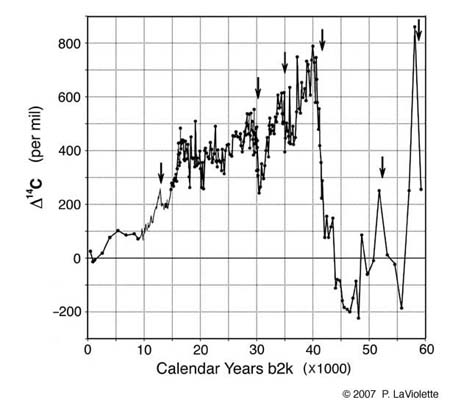OC inquired:
“Do you think the C 40,000 BC superwave event had anything to to do with this? Significant new information shows that the Campanian Ignimbrite (CI) eruption from the Phlegrean Fields, southern Italy, was much larger than hitherto supposed and in fact one of the largest late Quaternary explosive events. The eruption can be dated to 40,000 calendar years ago, within the interval of the so-called Middle to Upper Paleolithic ‘transition’. Its position can be precisely correlated with a number of other environmental events, including Heinrich Event 4 (HE4), the Laschamp excursion, and a particular cosmogenic nuclide peak.”
Yes, many of the events you describe here would have been caused by the 40,000 years before present superwave. Actually the Vostok ice core indicates that the beryllium-10 concentration peak (the cosmogenic nuclide peak) began its rise around 45,000 years before present (B.P.), or around 43,000 years B.C; see the Vostok Be-10 chart below.
The 40,000 superwave passage date that I had estimated from the observed polar azimuthal extent of the Fermi bubble relative to the galactic plane was based on the assumption that we lie 23,000 light years from the Galactic center. Other astronomers prefer to use a slightly greater distance estimate of 26,000 light years. If we were to instead use the 26,000 light year distance value, we would then calculate a superwave passage date of 45,000 years B.P. So we can say that the Fermi gamma ray bubble predicts that its associated superwave would have passed the Earth between 40 and 45 thousand years ago.
Looking at the Cariaco Basin radiocarbon record, we see that there was also a pronounced and prolonged rise in the atmosphere’s radiocarbon excess. This began around 44,000 years ago and peaked around 40,000 years ago; see graph below.

Radiocarbon record from the Cariaco Basin ocean sediment core (Hughen, et al. 2004). Arrows indicate times of rapid increase in C-14 excess.
This too was likely due to the arrival of superwave cosmic rays from the Galactic center. At no time in the past 50,000 years did Earth experience such a pronounced and prolonged rise in atmospheric C-14 concentration. The superwave would have injected cosmic dust into the solar system and this would have aggravated the Sun causing an increase in severe solar storms. So it is not surprising that we find the Laschamp excursion coinciding with this event. Also Heinrich event H5 occurred in the midst of this event (42,000 to 43,000 years B.P.). As I describe in my dissertation update http://etheric.com/LaVioletteBooks/EUF-CD.html, Heinrich events mark times of pronounced glacier wave activity when sudden climatic warming caused mountainous waves of glacial meltwater to sweep across the ice sheets and out into the ocean, depositing continental debris far out to sea. This would be another symptom of a superwave passage. It is difficult to tell if the CI volcanic eruption was also causally associated with the superwave passage. For a causal connection one might either look to isostatic changes due to ice sheet thickening or thinning, or to gravity wave effects.
OC further inquired:
“Regarding the beryllium-10 concentration peaks (please remember I’m not a scientist), there is one around the time of the Toba super-volcano explosion … roughly 73,000 BC as well. What could be said about that event with relation to a superwave event (gravity wave connected?), or do we know?”
This is an interesting observation. Two major volcanic eruptions appear to correlate with the dates of major Be-10 peaks in the Vostok record, i.e., with passage dates of major superwaves. It would be interesting to do a complete statistical analysis of volcanic eruption dates to see if a sound correlation is found with Be-10 peak dates. I have not done this.
P. LaV.


Hi Dr LaViolette
I’m trying to finalize this idea. I was curious, based on the information below, if possibly there was a superwave in and around the 25,000 BC time period. The first set of numbers point to the minor superwave C3300 BC, the event C 13,000 BC … and then there’s that last date C 25,000 BC.
…………………
The Be-10 data was shown by Liritzis and Grigori in 1998 to contain significant periods at 5,400, 12,200, and 25,400 years which fall in the range of the 10(4th) year recurrence LaViolette had predicted.
http://www.starburstfound.org/LaViolette/Bio/Bio3.html
…also Taupo supervolcano blew and Vesuvius.
The Oruanui eruption of the Taupo Volcano was the world’s largest known eruption in the past 70,000 years, with a Volcanic Explosivity Index of 8. It occurred around 26,500 years ago and generated approximately 430 km³ of pyroclastic fall deposits …
https://en.wikipedia.org/wiki/Taupo_Volcano
The mountain (Vesuvius) started forming 25,000 years ago. Although the area has been subject to volcanic activity for at least 400,000 years, the lowest layer of eruption material from the Somma mountain lies on top of the 34,000 year-old Campanian Ignimbrite produced by the Campi Flegrei complex, and was the product of the Codola plinian eruption 25,000 years ago. http://en.wikipedia.org/wiki/Mount_Vesuvius#Formation
By about 30,000 years ago, Mount Mazama began to generate increasingly explosive eruptions that were followed by thick flows of silica-rich lava, an outward sign of the slow accumulation of a large volume of highly explosive magma deep beneath the volcano. Grouse Hill and Redcloud Cliff are thick lava flows erupted between 30,000 and 25,000 years ago.
http://pubs.usgs.gov/fs/2002/fs092-02/
Tower Hill in Australia erupted 25,000 years ago.
Berlin Volcano Eruptions 25,000 years ago.
Lassen Peak is the largest of a group of more than 30 lava domes in the Lassen domefield. Such domes are near-vent accumulations of highly viscous lava. About 27,000 years ago, Lassen Peak formed over a short time, probably no more than a few years.
https://www.nature.nps.gov/geology/usgsnps/lassen/lassenfact.html
Thank you
OC